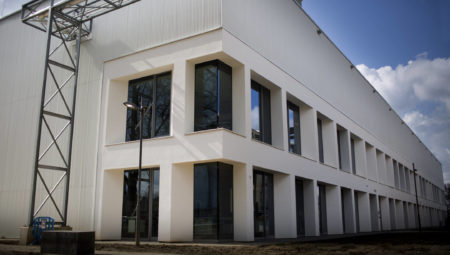Switching over
Emmo Meijer, standard bearer for Source B among other things, was involved in paving the way for an open innovative campus on the DSM grounds in Geleen around the turn of the century.
‘At the time I was working as Research Manager at DSM. DSM decided to divest itself of certain activities in the short to medium term. This meant that other parties would set up on the premises and would also want to use the facilities, such as R&D laboratories. This became a reality when the polymer business was sold to Sabic in 2002. The coming of this “odd man out” signified a change in mentality at the same time. It was no longer purely DSM, but a site where other businesses could establish themselves. That is also why the name was changed earlier from DSM Research to Chemelot.’
Different dynamics
More and more businesses set up at Chemelot by taking over DSM activities, but newcomers also arrived, such as Sappi and Avantium, or spin-offs of DSM like Isobionics and Yparex. There are now more than 50 businesses.
Meijer: ‘In a relatively short period, a completely new ecosystem has arisen, which certainly brings a dynamics with it that is totally different to just one multinational with its own company culture. The profile at Chemelot is diverse, with Dutch and international businesses targeting divergent markets. There is one important common denominator: high-quality sustainable chemistry and (biomedical) materials.’
Heart of Brightlands
Activity alone is not enough for an open innovation campus, according to Meijer. ‘Educational and research institutes and new activity are preferably under the same roof. This in turn leads to intensive interaction, which makes the campus model unique. You need knowledge workers, students and R&D people at the companies to achieve this. These interactions really come into their own if they are concentrated at a specific location. You can see this in Eindhoven, at the High Tech Campus where the Strip forms the dynamic heart. That is the role we also envisage with the Center Court.’
Brightlands Materials Center
The latter building is not the only ‘catalyst’ for innovation as far as smart, sustainable materials are concerned. Brightlands Materials Center opened its doors last year. This new knowledge centre, targeting the development of polymer materials, is a place where businesses and knowledge and research institutes work together closely. The budget for the next five years: 45 million euros.
The Multipurpose Pilot Plant, opened at the start of 2016, is another initiative in which businesses (Sappi, Avantium and Technoforce), research institutes and the government have combined forces. The planned expansion of the campus to the north is also important. ‘It will allow us to facilitate start-ups that want to scale up or expand.’
On target
It would not have been possible to develop the campus if the Province had not participated, according to Meijer. ‘You can only realise a campus development in a triple helix: the business sector, knowledge and research institutes, and the government. The province of Limburg not only contributed in word to the realisation of Brightlands Chemelot Campus, but most definitely also in deed. That is how we have managed, together with the existing Industrial Park, to be on target for our ambition: the most competitive chemical and sustainable materials site in Western Europe in 2025.’



